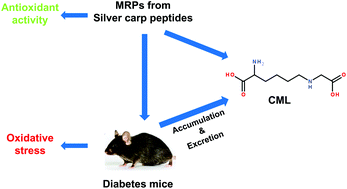Antioxidant balance and accumulation of advanced glycation end products after the consumption of standard diets including Maillard reaction products from silver carp peptides†
Abstract
The aim of this research was to investigate the accumulation and excretion of AGEs including fluorescent compounds and N-ε-carboxymethyllysine (CML) in streptozotocin-induced diabetes C57BL/6J mice fed on a diet containing Maillard reaction products (MRPs) from a silver carp peptide–glucose model system at different heating temperatures for the first time, and analyze the relationship between their in vitro antioxidant activity based on DPPH and ORAC assays and in vivo oxidative stress. The in vitro antioxidant activity of MRPs positively correlated with their AGEs level and molecular weight distribution. However, the opposite results were found by malondialdehyde (MDA) and super oxide dismutase (SOD) assays that MRPs from a higher heating temperature could aggravate the oxidative stress of diabetic mice. CML accumulation in serum was aggravated, but changes of MRPs in diets hardly affected CML accumulation in the kidney and liver. Therefore, the high AGEs levels from a diet containing peptide MRPs have negative effects on the oxidative stress of diabetic mice.


 Please wait while we load your content...
Please wait while we load your content...